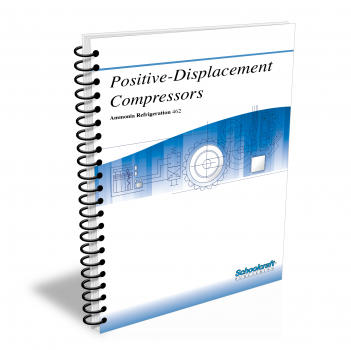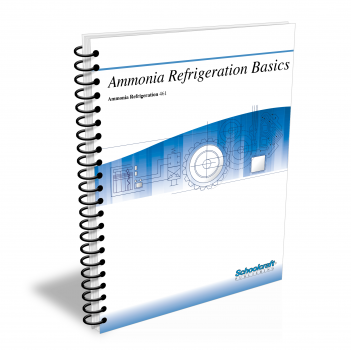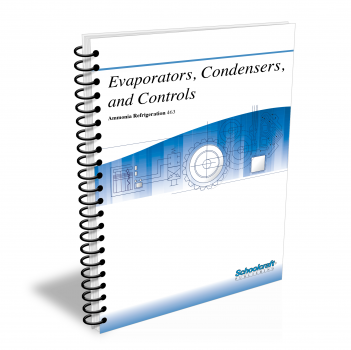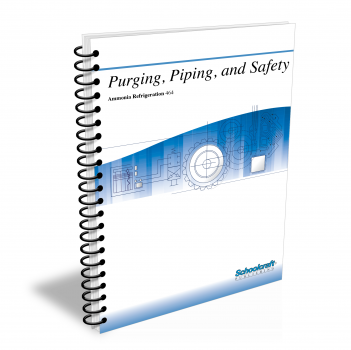Positive-Displacement Compressors

Course Number: 462
The Positive-Displacement Compressors textbook begins with coverage of reciprocating compressors; their design, lubrication, efficiency, and application. Next, it covers rotary vane compressor operation and limitations, and details screw compressors and the operation of related drive, lubrication, capacity control, and safety systems. Finally it discusses oils and the importance of system lubrication.
Does your curriculum require additional topics not included in this textbook? Build a customized version of the Positive-Displacement Compressors textbook below.
Recommended Contact Hours – 10
Preview a Chapter
Available Supporting Material
- Table of Contents
- Exam Copies
- Suggested Titles
Table of Contents
Chapter 1: Reciprocating Compressors
Topics: Features of industrial ammonia reciprocating compressors; Capacity control; Lubrication; Efficiency; Application data; Compound compressors
Learning Objectives:
- Briefly describe the evolution of ammonia reciprocating compressors.
- Describe typical design features of today's reciprocating compressors.
- Explain how capacity control and proper lubrication are achieved in ammonia reciprocating compressors.
- Explain how to use volumetric and adiabatic efficiency data and the performance factor in sizing or selecting compressors for an application.
- Describe the function and basic design requirements of internally compounded reciprocating compressors.
Chapter 2: Sliding-Vane Rotary Booster Compressors
Topics: Rotary vane compressor design and operation; Fixed volume ratio; Applicability; Limitations; Capacity control
Learning Objectives:
- Describe the basic operation of sliding-vane rotary booster compressors.
- Explain the principle of fixed volume ratio compressors.
- Describe typical rotary compressor design features.
- Explain why sliding-vane rotary compressors have been replaced by screw compressors.
- Discuss the reasons for rotary vane compressor speed limitations and the causes and effects of blade wear.
- Describe how capacity control is achieved in rotary compressors.
Chapter 3: Oil-Flooded Screw Compressors
Topics: Oil-flooded screw compressor operation; Fixed volume ratio; Capacity control in fixed, variable compressors; Efficiency; Compound compressors; Application criteria
Learning Objectives:
- Discuss the developments that led to the use and acceptance of the oil-flooded screw compressor in industrial refrigeration.
- Describe typical design features of single-screw and twin helical screw compressors.
- Explain how the compression system works within screw compressors.
- Compare fixed and variable volume machines and their applications.
- Explain how the capacity-control slide valve and variable Vi slide stop function.
- Describe the general range of application for screw compressors.
Chapter 4: Screw Compressor Units
Topics: Screw compressor systems; Drive systems; Lubrication, refrigerant/oil separation, oil cooling, economizer/side load, capacity control, microprocessor control, and safety systems
Learning Objectives:
- Explain why screw compressors are provided as units and describe the main systems that make up the screw compressor unit.
- Explain why a vertical or horizontal oil separator may be preferred and explain why check valves are used on the unit inlet and outlet connections.
- Discuss drive methods and oil distribution methods used on screw compressors and describe tasks provided by the lubricant within the compressor.
- Explain how the refrigerant vapor/oil separation system operates and list the methods and benefits of oil cooling in screw compressor units.
- Discuss the beneficial uses of the side port and the operation of the screw compressor capacity reduction slide valve control system.
- Name the codes and other criteria with which ammonia refrigeration systems must comply to establish and maintain a safe work environment.
Chapter 5: Ammonia Systems Lubrication/Oil Management
Topics: Need for lubrication; Miscibility; Viscosity; Lubricants and oils; Lubricant selection, handling and management; Separators; Low-side oil recovery
Learning Objectives:
- Discuss the purposes of lubricants in ammonia systems.
- Define the terms used to describe and specify lubricants and oils and discuss the importance of the miscibility and viscosity relationships between lubricants and ammonia.
- Describe the proper methods for handling lubricants.
- Explain how oil is separated from the refrigerant vapor within the screw compressor system.
- Describe the IIAR-approved method for removing oil from the system low-side oil pots.
- Name lubricants recommended for use with ammonia systems and explain the importance of using only specified lubrication products.
Request Exam Copies
Exam Copies
Ready to see a copy of our textbooks? After selecting which textbooks you’d like to review for your course, you can submit your request by either logging in or creating an account so we know where to ship your exam copies. A representative from Schoolcraft will contact you to confirm and finish processing your request.
Exam copies are always free and yours to keep.
Selected Exam Copies
none selected
* Maximum of five copies can be ordered


